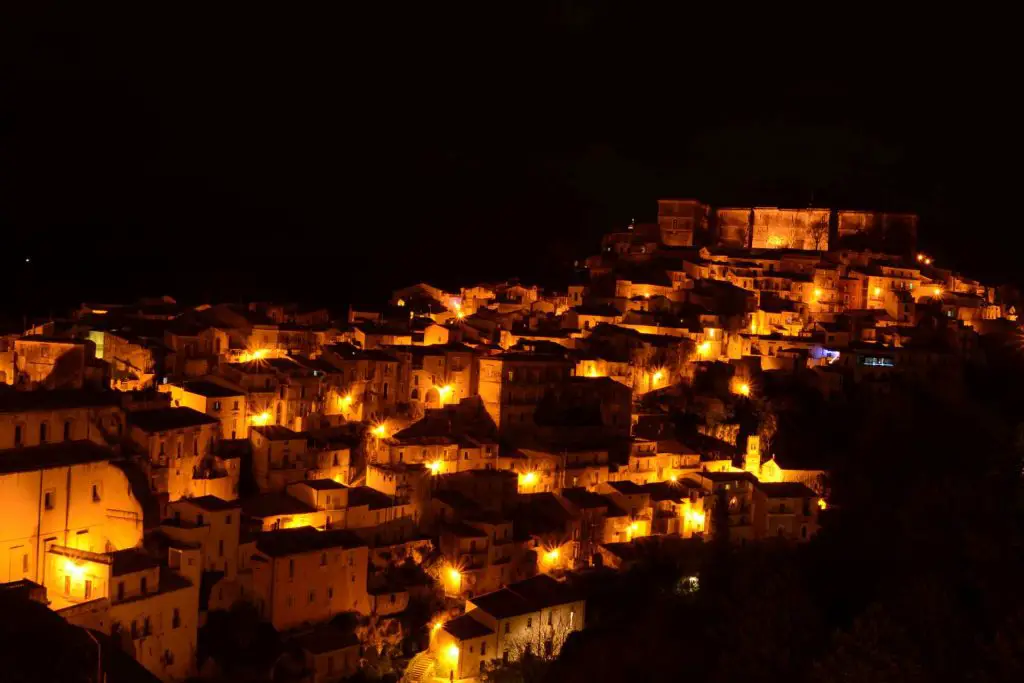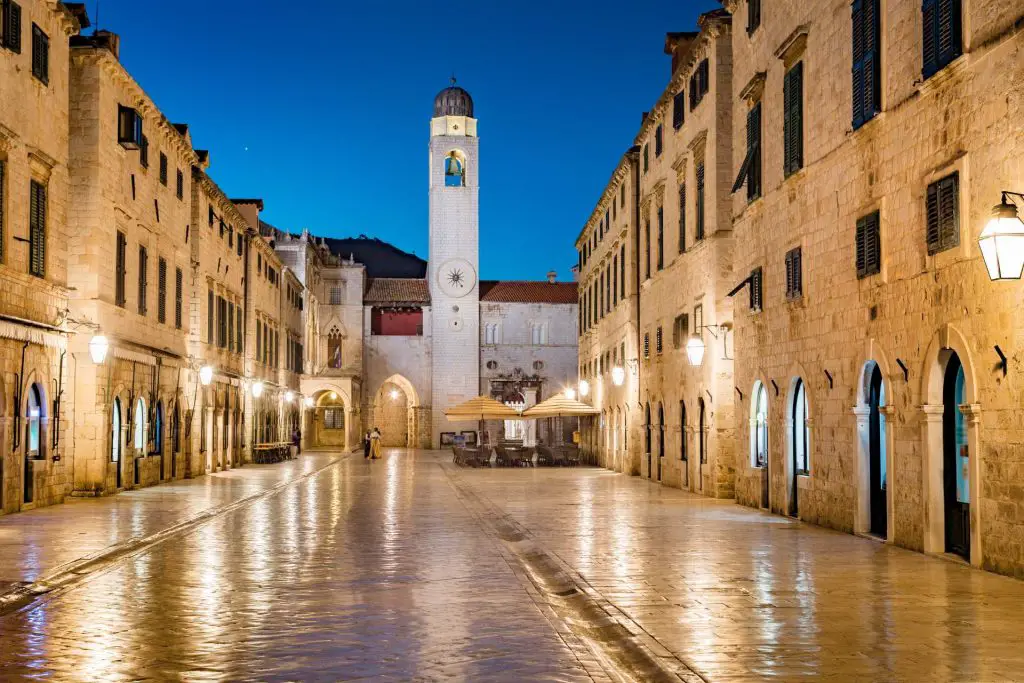“Keep your eyes on Ragusa, the most beautiful of cities.”
Salvatore Quasimodo
Perched atop a limestone hill in southeastern Sicily, the town of Ragusa is split into two distinct centers – the more modern upper town called “Ragusa Superiore”, and the older, evocative “Ragusa Ibla” below. This unique divided city offers visitors a captivating journey through Sicily’s rich history, architectural marvels, and culinary delights.

A tale of two Ragusas: origins and history
The origins of Ragusa date back to ancient times when the area was inhabited by the Sicels and later the Greeks. The city’s name is believed to derive from the Arabic term “Ragusah” meaning “dwelling built on a lofty mountain surrounded by walls.” Ragusa’s golden age arrived in the 14th-16th centuries when the city flourished under Spanish rule as a center of the wheat and wine trade. Grand palaces, churches, and public buildings were constructed in the ornate Baroque style. This architectural splendor defines the character of Ragusa Ibla today.
In 1693, a devastating earthquake leveled much of southeastern Sicily, including parts of Ragusa.
In the aftermath, many left the ruined lower town and rebuilt anew on higher ground, establishing the grid-plan upper city of Ragusa Superiore. This division into two centers gives Ragusa its unique dual personality. UNESCO designated Ragusa as a World Heritage Site in 2002, recognizing its importance as “an outstanding example of a late Baroque town, which has been continuously revived through the ages down to the present day.”
Ragusa Ibla: a living museum
To truly experience the soul of Ragusa, visitors must descend into the labyrinthine lanes of historic Ragusa Ibla. Walking these streets feels like stepping back in time to the 16th century. Beautifully preserved palazzi, churches, and buildings display an array of ornate Baroque facades adorned with carved masks, anthropomorphic figures, and decorative limestone details.
Ragusa Ibla’s most famous landmark is the Duomo di San Giorgio, an imposing cathedral that commands the town’s central square, Piazza del Duomo.
Construction began in the 12th century, but it wasn’t until the 18th century that the Baroque architects made their mark with the grand facade, soaring bell tower, and lavish interior. Other notable sights include the Baroque Church of Santa Maria dell’Itria, with its distinctive sunken courtyard, and the Chiesa di San Giuseppe, noted for its intricate stone carvings. The Gothic-Catalan Palazzo Cosentini exemplifies the town’s eclectic architectural heritage, while the 18th century Giardino Ibleo is a haven of tranquility tucked behind grand palace walls. Woven into the fabric of Ragusa Ibla are also hidden gems like arched passageways, cobblestone stairways, sunny piazzas, and shady cortili, all inviting exploration.
A tale of two Ragusas: exploring Ragusa Ibla in 2024
Considering a trip to Ragusa Ibla in Sicily? As we said, even under a blanket of clouds, Ragusa Ibla, a UNESCO World Heritage site in Sicily, radiates beauty. Its pastel-colored buildings cascade downwards, revealing hidden cobblestone alleys, charming Sicilian eateries, and inviting cafes. It’s an absolute must-visit in Sicily, and this guide is your perfect companion for the journey! Despite being part of Italy, Sicily presents a distinct charm, feeling almost like a separate nation. Ragusa Ibla offers a unique experience, ensuring you’ll find it thrilling.

A Dive into History
Ragusa Ibla’s narrative is deeply rooted in history. The 1693 earthquake left Ragusa in ruins, claiming approximately 5,000 lives. The city saw a rebirth, with the Baroque architecture of its reconstruction still dominating its skyline. Most survivors moved to “Ragusa Superiore”, drawn by the safety of higher ground. Despite their eventual unification in 1926, the contrasting characters of Ragusa Superiore and Ibla remain evident, with the latter being a beacon for tourists, celebrated for its stunning Baroque architecture and churches.
Locating Ragusa Ibla
Perched on Sicily‘s southern tip, Ragusa Ibla serves as an excellent base for exploring the island’s iconic landmarks, including Syracuse, Catania, Mount Etna, the Valley of the Temples, and The Turkish Steps.
The best time for visiting Ragusa Ibla
Ragusa Ibla promises an unforgettable experience whenever you choose to visit. Sicily’s climate, however, is a factor to consider. The intense heat of July and August might deter some, despite being peak visiting times. Planning activities to avoid the midday sun is advisable, incorporating leisurely, extended lunches. These months also coincide with the bustling school holiday period. The transitional seasons of Spring and Autumn offer cooler temperatures and thinner crowds, except around Easter, with the latter still warm enough for beach outings. Winter brings milder but sunny weather, a stark contrast to colder climes, where a sweater suffices, though locals might opt for heavier winter wear.
Navigating Ragusa Ibla in 2024: your essential guide
Keep in mind that winter months might bring some hefty storms, but this shouldn’t deter you. Sicily’s allure is year-round, showcasing its beauty in every season.
Discovering Ragusa Ibla’s charms
Ragusa Ibla, perched on a hillside, is full of stunning stone residences and Baroque churches, each alley oozing with its unique allure. Here, history is alive in every corner, with numerous sites to explore, from ancient churches to historic edifices. Yet, for those less inclined towards historical sites, worry not. We’ve rounded up a variety of activities ensuring nobody’s left out – showcasing the essence of what makes Sicily renowned.

Ragusa Cathedral: a starting point in Ragusa Superiore
Begin your journey in Ragusa Superiore, the convenient start for bus arrivals and parking. Here, the Cathedral of San Giovanni Battista stands, mirroring the architectural style found throughout Ragusa Ibla. Surrounded by quaint cafes, it’s a perfect spot to rest. Across from it, the tourist office awaits to equip you with maps and insights for your exploration. Venture towards Ragusa Ibla, where a scenic staircase descends into the historic town, offering breathtaking vistas of the ancient buildings – scenes famously captured in the ‘Inspector Montalbano’ series. As evening falls, the town’s warm glow adds a magical touch to the landscape.
The Church of Santa Maria delle Scale: a historic gateway
Positioned between Ragusa’s two parts, this church is a must-see, known for its Baroque enhancement post-18th century, despite its 13th-century Gothic origins.
A tale of two Ragusas: Basilica of San Giorgio
With its neoclassical dome visible throughout Ragusa Ibla, the Basilica di San Giorgio, built in 1738, is a beacon of Baroque architecture and a UNESCO World Heritage highlight.
San Giuseppe Church: a baroque jewel
In the heart of Ragusa Ibla, this 18th-century church dazzles with its ornate Baroque facade, adorned with statues representing the Benedictine order.
The Church of the Souls of Purgatory and Santa Maria Dell’Itria
These churches offer a glimpse into Ragusa’s resilient spirit and architectural diversity, from Baroque masterpieces to the unique influence of the Knights of Malta.
A tale of two Ragusas: San Filippo Neri Church
Another testament to Ragusa Ibla’s Baroque legacy, built in the 17th century.
Don’t Miss: The Valley of the Temples, a short drive away, offers an immersion into Sicily’s ancient history.

A tale of two Ragusas: relaxation and exploration
Piazza Duomo, with its stunning views and the tranquil Hyblean Gardens, provides perfect spots for a leisurely break amidst sightseeing.
- Experience local culture: engage in a private cooking class or a personalized tour combining historic sights with Sicilian wine tasting for an authentic local experience.
- Dining in Ragusa Ibla: satisfy your cravings with traditional Italian cuisine or indulge in a rich hot chocolate, a Sicilian specialty not to be missed.
- Practical advice for visitors: consider attire suitable for church visits, plan for parking in Ragusa Superiore, and wear comfortable shoes for navigating cobblestone streets. Exploring Ragusa Ibla is ideal for both short visits and extended stays, offering a wealth of sights, activities, and experiences suitable for all, including families with children, thanks to its safe environment and child-friendly attractions. Remember to pack essentials like sunscreen or a raincoat, a water bottle, and a hat, ensuring a comfortable and enjoyable visit to this enchanting Sicilian town.
A tale of two Ragusas: Ragusa Superiore
While Ragusa Ibla enchants with its medieval atmosphere and Baroque splendor, the upper town of Ragusa Superiore offers a glimpse into the city’s modern face. Here you’ll find an orderly grid of streets, piazzas, and buildings from the 18th century, constructed after the devastating earthquake.
The focal point of Ragusa Superiore is the grand Cathedral of San Giovanni Battista, an imposing domed Baroque church with intricate sculptural details on its facade.
Other sites include the Church of the Souls in Purgatory, noted for its Gothic arched portico and macabre carvings of contorted souls on the facade. While Ragusa Superiore lacks the romantic ambience of Ragusa Ibla, its location atop the limestone promontory offers panoramic views over the historic center below and the patchwork of rural valleys beyond. As the sun sets, strolling along the Corso XXV Aprile is a perfect way to experience the vibrant evening passeggiata (promenade) among locals.

A tale of two Ragusas: savoring Ragusa’s Bounty
Like the rest of Sicily, Ragusa is a culinary paradise showcasing the island’s heritage of fresh, simple ingredients and bold flavors influenced by Greek, Arabic, Norman, and Spanish traditions. Visitors can feast on an abundance of artisanal cheeses, olives and olive oil, fresh seafood, sun-ripened produce, and regional specialties like arancini (stuffed rice balls), Cartoccio Ragusano durum wheat pasta, and sweet Marsala dessert wines.
One of Ragusa’s signature dishes is the inimitable cheese, Ragusano DOP.
This stretched curd cheese has a texture similar to caciocavallo and flavor hinting of herbs. It’s often shaved over pasta dishes or enjoyed on its own with local honey or wine. The iconic Ragusano street food is the scaccia ragusana, a folded flatbread filled with tomatoes, anchovies, onions, herbs and local cheeses. Other savory handheld options include panino con la milza (sandwiches with spleen and cheese) and panzerotti (fried bread pockets).
No culinary tour is complete without sampling the sweet treats of Ragusa’s bakeries and pasticcerie. Highlights include the iconic cannoli filled with sweet ricotta, rugbiera (fried dough knots scented with lemon), and biscotti con l’ammendola (almond macaroons) – perfect for enjoying with a robust espresso or Marsala wine.
A tale of two Ragusas: getting there and getting around
The nearest airport for Ragusa is in Catania, about 90 minutes away by car or train. Some visitors opt to fly into Palermo and drive across the island. Once in Ragusa, the historic centers of Ragusa Ibla and Ragusa Superiore are compact and walkable. The most scenic way to move between the two centers is via the Scalinata di Ragusa, sometimes called the “Stairway of Darkness” – a winding series of stairs and tunnels connecting the upper and lower towns through the limestone hillside. Taxis and a tourist road train also provide transportation between the two.
With its enchanting historic atmosphere, cultural treasures, and culinary bounty, Ragusa offers an unforgettable taste of Sicily’s rich heritage. Keep following us to discover everything about Sicily and our brand new LCN App.


